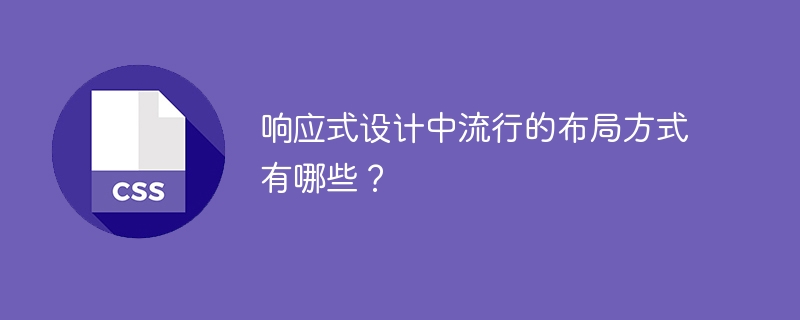What are the popular layout methods in responsive design?

Responsive design is a design method that achieves a consistent user experience across different devices. With the popularity of mobile devices, more and more people use screens of different sizes to access web pages, so responsive design has become an important part of modern web design. In practice, designers use various layout methods to achieve responsive design. This article will introduce some popular responsive design layout methods.
- Fluid grid layout (Fluid grid layout)
Fluid grid layout is the most basic and commonly used layout method in responsive design. Web page elements use percentages instead of fixed pixels to set their width, allowing the element's size to automatically adjust to the screen size. In this way, the layout of the web page will automatically adapt when it is displayed on screens of different sizes. - Media query layout (Media query layout)
Media query layout allows designers to apply different styles and layouts for different screen sizes. Designers can use the media query function of CSS to detect the characteristics of the screen and then apply different styles based on different characteristics. For example, designers can choose to display a different number of columns based on the width of the screen, or adjust the size and position of elements. - Flexible grid layout (Flexible grid layout)
Flexible grid layout implements responsive layout by using the flexible box model (Flexbox). This layout dynamically adjusts the size and position of elements to accommodate different screen sizes. Designers can specify the scalability of elements so that they automatically adjust horizontally and vertically. - Image placeholder layout (Image placeholder layout)
Image placeholder layout is a layout method that uses placeholders to replace images before loading them. When the image is loaded, the placeholder will be automatically replaced by the real image, which can avoid page jitter during image loading. This layout improves page loading speed and provides a better user experience. - Dynamic content layout (Dynamic content layout)
Dynamic content layout is a method of adjusting the layout based on dynamic changes in content. For example, when the text content on the page becomes longer, designers can use automatic word wrapping or scroll bars to accommodate the growth of the content. This layout method can adapt to changes in dynamic content and provide better readability and user experience.
To sum up, popular layout methods in responsive design include fluid grid layout, media query layout, elastic grid layout, picture placeholder layout and dynamic content layout. Designers can choose the appropriate layout method based on specific project needs and target audience to achieve a consistent user experience across different devices.
The above is the detailed content of What are the popular layout methods in responsive design?. For more information, please follow other related articles on the PHP Chinese website!

Hot AI Tools

Undresser.AI Undress
AI-powered app for creating realistic nude photos

AI Clothes Remover
Online AI tool for removing clothes from photos.

Undress AI Tool
Undress images for free

Clothoff.io
AI clothes remover

AI Hentai Generator
Generate AI Hentai for free.

Hot Article

Hot Tools

Notepad++7.3.1
Easy-to-use and free code editor

SublimeText3 Chinese version
Chinese version, very easy to use

Zend Studio 13.0.1
Powerful PHP integrated development environment

Dreamweaver CS6
Visual web development tools

SublimeText3 Mac version
God-level code editing software (SublimeText3)

Hot Topics
 1379
1379
 52
52
 Working With GraphQL Caching
Mar 19, 2025 am 09:36 AM
Working With GraphQL Caching
Mar 19, 2025 am 09:36 AM
If you’ve recently started working with GraphQL, or reviewed its pros and cons, you’ve no doubt heard things like “GraphQL doesn’t support caching” or
 Building an Ethereum app using Redwood.js and Fauna
Mar 28, 2025 am 09:18 AM
Building an Ethereum app using Redwood.js and Fauna
Mar 28, 2025 am 09:18 AM
With the recent climb of Bitcoin’s price over 20k $USD, and to it recently breaking 30k, I thought it’s worth taking a deep dive back into creating Ethereum
 Creating Your Own Bragdoc With Eleventy
Mar 18, 2025 am 11:23 AM
Creating Your Own Bragdoc With Eleventy
Mar 18, 2025 am 11:23 AM
No matter what stage you’re at as a developer, the tasks we complete—whether big or small—make a huge impact in our personal and professional growth.
 Vue 3
Apr 02, 2025 pm 06:32 PM
Vue 3
Apr 02, 2025 pm 06:32 PM
It's out! Congrats to the Vue team for getting it done, I know it was a massive effort and a long time coming. All new docs, as well.
 Can you get valid CSS property values from the browser?
Apr 02, 2025 pm 06:17 PM
Can you get valid CSS property values from the browser?
Apr 02, 2025 pm 06:17 PM
I had someone write in with this very legit question. Lea just blogged about how you can get valid CSS properties themselves from the browser. That's like this.
 A bit on ci/cd
Apr 02, 2025 pm 06:21 PM
A bit on ci/cd
Apr 02, 2025 pm 06:21 PM
I'd say "website" fits better than "mobile app" but I like this framing from Max Lynch:
 Comparing Browsers for Responsive Design
Apr 02, 2025 pm 06:25 PM
Comparing Browsers for Responsive Design
Apr 02, 2025 pm 06:25 PM
There are a number of these desktop apps where the goal is showing your site at different dimensions all at the same time. So you can, for example, be writing
 Stacked Cards with Sticky Positioning and a Dash of Sass
Apr 03, 2025 am 10:30 AM
Stacked Cards with Sticky Positioning and a Dash of Sass
Apr 03, 2025 am 10:30 AM
The other day, I spotted this particularly lovely bit from Corey Ginnivan’s website where a collection of cards stack on top of one another as you scroll.




